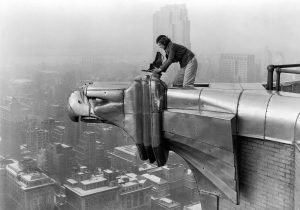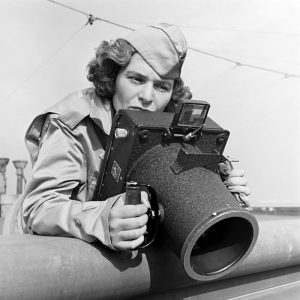
A couple of weeks ago, I shared an article that Popular Photography wrote in December 1937 about New York street photographer Arthur “Weegee” Fellig who at the time was an unknown photographer who had a knack for capturing some of the darkest moments of humanity on the streets of New York.

This week’s Keppler’s Vault comes from the December 1943 issue of Popular Photography and introduces Margaret Bourke-White, who had recently been commissioned by Samuel Goldwyn to photograph the set of his new movie, “The North Star”.
With an impressive resume at the age of 39 when this article was written, Bourke-White, known in Hollywood as “Peggy” had already traveled the world, covering Europe in the 30s, being one of the first western photographers to shoot the Soviet Union, even appearing on a radio broadcast from the country. She had written books and created a couple film shorts that helped educate western journalists to the perils of war and the rise of the Soviet Union.
The article tells the story of how Bourke-White got started with photography while attending Cornell University, shooting her second-hand Ica Reflex to help pay her bills. Her knack for composing images of architecture attracted the attention of a famous New York architect, who was so impressed with her work, persuaded her to make photography her career.
I’ll resist re-typing Bourke-White’s resume as it’s spelled out in detail in the article, but one thing that is immediately clear to me is that this lady had a serious case of GAS, as while shooting for Goldwyn, she brought no less than six cameras, including two Linhofs, a Rolleiflex, Speed Graphic and a British camera called the Soho Reflex. The article goes into detail about each of her cameras along with the lenses and flash equipment she would use to shoot Hollywood stars who quickly accepted her as a member of the “Hollywood elite” treating her as an equal, rather than some lady with a camera.
This short 10 minute documentary serves as a great 21st century introduction to Bourke-White, explaining some of her career highlights.
Throughout her career Margaret Bourke-White became one of the most influential photographers of the 20th century, photographing a huge list of historical figures such as Franklin Roosevelt, Winston Churchill, Josef Stalin, and Dwight Eisenhower. She famously shot construction of the Chrysler building in New York City, shot conflicts in Europe, North Africa, the Soviet Union, and was once torpedoed on a boat that sunk in the Mediterranean. It would be a disrespect to say she was one of the most influential female photographers, as doing so automatically suggests that women didn’t deserve to be compared to their male counterparts, which was definitely not the case.
Whether you think you already know Margaret Bourke-White or just like to be impressed, this is a fascinating glimpse into “Peggy” during the peak of her career!
All scans used with permission by Marc Bergman, 2020.



Mike, I’m positive that the camera that she is pictured with whilst on the gargoyle is the Soho Reflex, made for Marion, by Kershaw.
Great article. She was an awesome photographer.
During the early 1930s, Margaret Bourke-White had the coolest photographer’s studio ever, she inhabited and worked from an apartment on the 61st floor of the Chrysler Building. This is the level where is famously depicted sitting inside one of the stainless steel gargoyles holding her Graflex RB Auto camera, shot by her assistant Oscar Graubner in 1931. Apart from the gargoyles the views from the two terraces are spectacular, with one facing north and the other south. Walter Chrysler had the North facing floor, and Margaret Bourke-White cajoled her way into the South facing portion.
As the first female photojournalist hired by Life magazine, Bourke-White climbed skyscrapers and navigated battlefields to get compelling shots. She paved the way for many photographers of her time with her daring and intrepid spirit. Bourke-White, when she was in Cleveland, became a well-known industrial photographer. The Chrysler Corporation got to know her, and they hired her to photograph the final construction of the building from 1929 to 1930. She was on scaffolding and on towers about 800 feet off the ground. It got windy, and the scaffolding swayed from side to side. The assignment gave her the idea that she wanted to live in the Chrysler Building: she wanted the best address. At the same time Henry Luce had hired her to be the photographer for Fortune magazine.
According to Stephen Bennett Phillips, a curator at the Phillips Collection; organized the traveling exhibition “Margaret Bourke-White: The Photography of Design, 1927-1936,” she wanted the 61st floor, the terrace where two of the American eagle gargoyles are and where she climbed out to take some of her most well known photographs. No one else was living in the building at the time except for the janitor. Fortune, where she was the first photographer hired for the magazine, wouldn’t rent her the space on her own, because she was a single woman, even though she was making tens of thousands of dollars. Her lease had to be cosigned by Time Inc. She paid $387.92 per month, plus electricity — that was a lot of money back then. She moved in there in 1930 and hired her good friend, John Vassos, an industrial designer, to create an art deco stylish interior, with extensive custom built-ins, subdued palette, woods and metals. He added an alcove desk, a built in bar below a cantilevered fish tank with a stainless steel frame, and a conversation corner swathed in Fabrikoid, a chic, leather like fabric.
Bourke-White’s early interest in college and high school was herpetology: snakes, turtles. She had a fish tank in her studio and lots of creatures. Some friends coming back from Florida brought her two pet alligators, which she kept on the terrace in a specially constructed aluminum pond.
Stairs with a streamlined banister led to an outdoor terrace which Bourke White was not allowed to use. The building superintendent reminded Bourke-White that her lease did not include access to the terrace, and she wrote back, “Of course.” But promptly ignore the rule and invited businessmen whom she wanted to befriend to have cocktails on the terrace. Imagine having parties on the terrace overlooking Manhattan, and the famous silver gargoyles?
The spire, the cowl and crown, the eagle gargoyles at the 61st story, are all made of what, in 1929, must have looked like the material of the future, a type of German-made stainless steel called Nirosta. The shiny material is stainless steel produced in sheet stock called Enduro KA-2 from Germany. It was then hand-fabricated on site from two upper floors in the building. Imagine the precision on those intricate compound angles. This baby was custom built!
By 1932, the Depression was hitting hard, Fortune magazine is cutting back on what they were paying photographers and she began falling behind in her rent. By 1934 she was very far behind, owing $6,000, and is evicted. She found cheaper studio space on 521 Fifth Avenue. The alligators had grown fairly large, but she took them with her.
Annie Liebowitz took a photo in exactly the same position in 1991. The resulting picture appeared in the Times’ Arts & Leisure section on September 8, 1991
http://www.smithsonianmag.com/arts-culture/gaga-over-a-gargoyle-15902894/?no-ist
In January 2013 my friend Daredevil shutterbug Lucinda Grange, inspired by this image, sat 1,000 feet above Midtown for a spine-tingling self- portrait. The British adventurer, 24, has also scaled the Pyramids of Giza and the Brooklyn Bridge. Grange has traveled around the world for the past six years, risking death and arrest to capture her breathtaking photos.
http://www.theeyeofsilence.com/
Video: of the 61st floor http://www.youtube.com/watch?v=atH-hJhBx7Y#t=100
Cheyenne, fascinating. From what I have gathered the camera she was holding whilst perched on the gargoyle is more likely to be a Grayflex and not the Soho Reflex, although their outlines are remarkably similar.
Wow, great info Cheyenne! There is a ton to read about Bourke-White, and all of it is fascinating. I thought this article from 1942 was an especially cool read as it written during the peak of her career, rather than as a retrospective of her career.